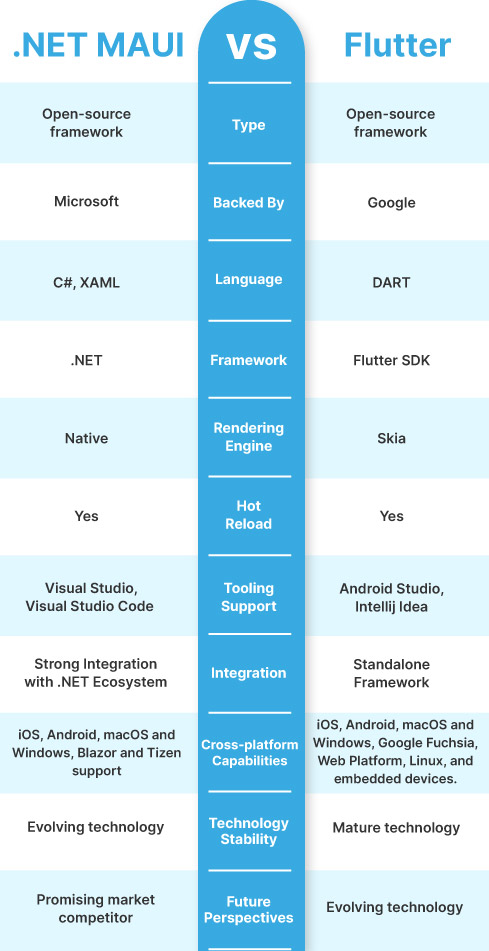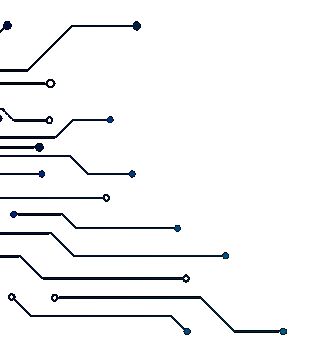Key Takeaways:
- In the comparison of .NET Maui vs Flutter, Google’s Flutter claims a larger market share, but Maui has Microsoft in the driver’s seat.
- .NET Maui is used to streamline cross-platform app development whereas Flutter is used to develop high-performance and appealing user interfaces and cross-platform applications.
- For businesses with a preference for strong integration with Microsoft’s ecosystem and .NET’s advanced features, it’s advisable to choose .NET Maui. Whereas, for businesses with a preference for high customization and a large community of developers, Flutter is the best deal.
In our series of comparing .NET with other development frameworks, we last discussed .NET vs Java.
Continuing with our series, today we will talk about one of the most discussed comparisons .NET MAUI vs Flutter.
Did you know?
Flutter is the most popular cross-platform framework used by developers, according to a 2022 developer survey – Confirms Statista.
Despite the hold Google-backed Flutter has had on the development market, the Microsoft-backed .NET MAUI is giving it a run for its money. So, leaders shouldn’t be surprised that .NET MAUI is able to compete with Flutter.
So, what brings you here amidst a busy day?
- Is it the need to develop robust cross-platform applications, paired with flawless functionality?
- Or perhaps the confusion surrounding the Flutter vs .NET debate that deserves your attention?
Relax, sit back, and grab a cup of coffee.
In this blog, we are going to answer all your questions through:
- What is .NET MAUI and what is Flutter?
- A realistic comparison between Flutter Vs NET MAUI
- Flutter vs .NET MAUI- When to use what?
Ready to explore?
Let’s go.
Before exploring .NET MAUI vs Flutter, let’s sneak peek into what these development frameworks are about.
What is .NET MAUI?
.NET MAUI which stands for Multi-platform App UI is an evolution of Xamarin.Forms.
Xamarin.Forms is an open-source cross-platform framework which will come to the end of its life on May 1, 2024.
Released in May 2022, Dot NET MAUI is a free, unified framework, which developers use to build cross-platform applications for Windows, Android, macOS, and iOS.
Wondering, “What’s the difference between Xamarin forms and .NET MAUI?”
.NET MAUI extends the capabilities of Xamarin from mobile to desktop with rebuilt UI controls for enhanced performance and extensibility.
In the debate of Flutter vs MAUI, it’s worth mentioning that MAUI comes with unique features such as single project experience, slim renderers, support for modern patterns, complete hot reload support, and unified libraries which aim to simplify the development experience.
The major components of the NET MAUI framework include-
- XAML Hot Reload
- Unified API Surface
- .NET MAUI Handlers
- .NET MAUI Extensions
- Dependency Injection (DI)
- Cross-platform UI Controls
What Can I Do with the .NET MAUI Framework?
You can use MAUI to create versatile cross-platform applications for mobile, desktop, and other devices, that run on Windows, macOS, Android, and iOS from a single shared code base, leveraging its fast performance, updated development features, and extensibility.
Now with those anecdotes, you are aware of the technological capabilities of Microsoft MAUI, putting you at ease with some solid advantages to debate.
While .NET MAUI can be easy to use, some of its advanced features could be hard nuts to crack.
You can always benefit from a team of proficient .NET developers from a renowned .NET Development company who strive to make your job easy.
Next in the debate of .NET MAUI vs Flutter, it’s time to throw a spotlight on the next contender, Google-backed Flutter.
What is Flutter?
Flutter is a Google-backed open-source UI software development toolkit designed for creating natively compiled apps for mobile, desktop, and web with a single codebase.
Released in 2017, Flutter has gained popularity for being a versatile and flexible framework that empowers developers to develop high-performance and visually appealing applications across multiple platforms.
The major components of Flutter include-
- Hot Reload
- Dart platform
- Flutter engine
- Foundation library
- Platform Channels
- Design-specific widgets
- Flutter Development Tools (DevTools)
What is Flutter Used For?
Flutter is a framework used to build, test, and deploy beautiful applications from a single codebase.
Since it functions within a single codebase and renders it into native code on each platform, Flutter developers can create native-like apps faster and with lower development costs.
Flutter is mostly used to develop apps that need to deliver highly branded designs.
Moving on, let’s take a step forward and take a sneak peek into the distinctive features of Flutter and MAUI.
.NET MAUI vs Flutter: Features

As we have knocked down the primary differences between Flutter and .NET MAUI, it’s time to spin back to the dilemma of Microsoft’s .NET MAUI or Flutter and dissect your decision-making process with a strategic approach.
A Realistic Comparison of Flutter vs .NET MAUI
Microsoft’s MAUI and Google’s Flutter are designed to share a common goal of revolutionizing cross-platform app development, yet both frameworks share a fundamental difference between their underlying technologies and ecosystems.
.NET MAUI vs Flutter – Here’s The Difference
We have split the differences into 2 major factors:
1. Business factors
2. Technical factors.
Let’s look at each factor one by one.
A. Business factors:
1. MAUI vs Flutter: Audience
MAUI is ideal for businesses already invested in the Microsoft ecosystem, and well-versed with the C# and XAML programming languages. It also appeals to a broader audience looking to develop cross-platform applications leveraging .NET technologies and infrastructure.
Flutter, on the flip side, caters to a broader audience, including businesses familiar with Dart, and those seeking a flexible solution and a reactive framework to develop cross-platform apps.
2. .NET MAUI vs Flutter: Performance
Top .NET development companies in the USA leverage Microsoft MAUI for its excellent performance.
Since NET MAUI offers platform-specific rendering, .NET developers can achieve a more native user interface for their applications across diverse platforms.
Although .NET MAUI is still under development, it offers direct native control access enabling efficient performance. However, its performance is expected to improve over time.
MAUI users also benefit from the performance advancements introduced in .NET 6.0, such as ahead-of-time (AOT) compilation and enhanced runtime performance.
Flutter engineers, like MAUI developers, enjoy exceptional performance, thanks to its usage of Dart, a compiled language, and the Skia rendering engine.
3. NET MAUI vs Flutter: Learning curve
.NET MAUI uses C#, a language developed by Microsoft, as its primary language. It is a widely used language for developing Windows applications in the enterprise world.
Although it has an intricate syntax than Flutter’s Dart, it’s a mature programming language with excellent support for object-oriented programming, making it an ideal choice for enterprise-scale development projects.
On the other side, Flutter uses Dart which has a relatively moderate learning curve and comes effortless for developers well-versed in JavaScript and Java.
Furthermore, its syntax is clean and easy to read, making it an ideal choice for developing applications that prefer simplicity and maintainability.
Is your business heavily invested in the Microsoft ecosystem?
Are you planning to develop a cross-platform application that is designed for multiple operating systems?
Consider outsourcing your requirements to a reliable .NET development company.
Why?
Because the technology partner takes care of all the hassle from sourcing the pre-vetted .NET developers to maintaining HR compliance while you solely get to pivot your energies on core business objectives and project success.
4. .NET MAUI vs Flutter: Programming Languages
Microsoft MAUI uses C#, one of the most popular languages on the .NET platform. Its programs can run on multiple devices from IoT devices to the cloud and everywhere in between.
Flutter, on the other hand, uses Dart which is known for its performance, productivity, and ease of use.
5. Flutter vs NET MAUI: Development Tools and Ecosystem
Microsoft MAUI comes with robust development tools that include Xamarin.Forms extensive ecosystem, Visual Studio, and Visual Studio Code Support, and access to the NuGet package.
Google Flutter comes with a wide range of packages and plugins, available through the pub.dev package manager. Flutter also integrates with prevalent code editors and IDEs, facilitating a smooth and efficient development experience.
5. .NET MAUI vs Flutter: Community Support and Popularity
Although .NET MAUI is relatively new, it is rapidly gaining popularity within both the developer and business communities.
It’s a growing ecosystem that offers a variety of plugins and resources for support and extension, enabling a robust development experience.
Microsoft further provides ample resources for developers including documentation, tutorials, and events encouraging a supportive learning and collaboration environment.
Flutter, on the other hand, is one of the most popular cross-platform frameworks.
It boasts strong and vibrant community support while Google complements this with excellent documentation and resources enabling a robust development experience.
Furthermore, Flutter is a growing ecosystem of packages and plugins which enhances Flutter’s appeal and versatility for businesses seeking high-performance applications.
Realize that it’s not ideal to make the choice based on market trends because the framework’s popularity may change within weeks or months, depending upon how fast it is evolving.
After discussing the business factors, it’s time to dive deep into the technical factors differentiating NET MAUI vs Flutter.
B. Technical factors:
1. .NET MAUI Or Flutter: Technology Stability
Since .NET MAUI is an upgraded version of Xamarin.Forms, it inherits the legacy of reliability and stability of Xamarin while also incorporating the latest features and upgrades.
This combination promises that businesses benefit from the proven track record of Xamarin.Forms and the feature upgrades introduced in MAUI.
Moreover, Microsoft’s track record of delivering reliable technologies serves as a commitment to the success of .NET MAUI.
Flutter, on the flip side, is backed by Google, promising continuous innovation and technical stability. However, its ecosystem may not be as mature as Microsoft’s .NET which can affect the quality of certain features and resources.
2. .NET MAUI versus Flutter: Development Process
.NET MAUI comes with Live Visual Tree updates and features like hot-reload, making it an ideal platform for speedy and efficient development.
Moreover, the MAUI framework is equipped with a new markup called XAML Hot Reload, which makes it efficient to create user interfaces using a declarative syntax.
This speeds up the development process for the .NET developer who has hands-on experience working with XAML.
Flutter is the talk of the town for its fast development process, thanks to its hot-reload feature. The hot reload feature enables developers to see the results of their code changes without having to restart the app, which in turn boosts productivity and enables rapid application development.
Moreover, Flutter’s library of ready-to-use widgets simplifies the creation of building appealing user interfaces.
3. .NET MAUI vs Flutter: Cross-Platform Capabilities
Both .NET MAUI and Flutter equip robust cross-platform capabilities and empower developers to write code once and deploy it across various platforms through different approaches.
.NET MAUI uses a unified API to develop applications for Windows, Android, macOS, and iOS. However, you can also leverage the native capabilities of each operating system as it boasts a unique implementation for each platform.
This approach ensures flawless functioning across each platform and maintains its native look and feel.
Flutter takes a ‘write once, run anywhere’ approach to cross-platform development where the same codebase can be used for all platforms. This approach facilitates easy maintenance and updates for the application as all changes are reflected across all platforms.
Now that we are through with the differences between NET MAUI vs Flutter, we’re confident that you have found the answers to your question.
Still uncertain about Flutter vs .NET MAUI?
Worry not!
Having discussed how Flutter and MAUI are fundamentally different, keep reading to discover how to find “The One”.
.NET MAUI vs Flutter – When to Use What?
Flutter and .NET MAUI stand at the forefront of the cross-platform app development industry, offering a myriad of perks that solidify their positions as leading frameworks in the industry.
They offer a great development experience with unique features that cater to different business needs.
When to Use .NET MAUI?
.NET MAUI makes an ideal choice when your business goal is to:
- Build enterprise-level applications with improved efficiency.
- Develop mobile apps for Windows, iOS, or Android by using a single codebase.
- Build a native-like interface, achieve performance boost and impeccable user performance.
- Transit Xamarin.Forms projects to .NET MAUI.
- Seek seamless integration with the Microsoft ecosystem and .NET’s advanced features.
When to Use Flutter?
Flutter makes an ideal choice when your business goal is to:
- Achieve a high level of customization and a visually appealing UI.
- Your existing project is compatible with Dart.
- Develop web and mobile applications using a single codebase.
- Invest in a framework with an active community of developers and a plethora of third-party packages and plugins available.
- To accelerate your development cycle with the Hot Reload feature.
The best course of action is to first assess your cross-platform application development needs and then choose between .NET MAUI vs Flutter.
Impressed with the capabilities of .NET MAUI, have you decided to opt for it?
Congratulations!
We are happy to have helped you arrive at your decision.
You, being a visionary leader, are aware of the value that .NET development services providers bring to the table.
If you’re looking for a reputed .NET development partner who will help you harness the full potential of the MAUI framework, Integrative Systems has your back.
We are –
- A Certified Microsoft Partner
- USA’s leading .NET development company
- An INC 5000 One of America’s Fastest Growing Company
What makes us stand apart from our true .NET expertise is we deliver value to our clients with every engagement.
Think we are the match made in heaven?
Drop us an email at [email protected] or call us at 1.866.468.7974 (INTSYSI) and we’ll get back to you within 2 business days.
Frequently Asked Questions about Flutter vs MAUI
1. Is .NET MAUI the Same as Xamarin Forms?
Ans- Xamarin.Forms and .NET MAUI are not the same. While Xamarin.Forms has played a crucial role in cross-platform app development, the MAUI framework is its evolution.
2. Is .NET MAUI Good for Desktop Applications?
Ans- NET MAUI is an ideal choice for modern desktop app development. It comes with growing community support, enhanced capabilities, extensive documentation, and Microsoft’s backing which makes it a smart choice for desktop application development.
3. Should I Use Xamarin or Flutter?
Ans- The choice between Flutter or Xamarin (Now MAUI) depends on your cross-platform application development needs. Do you prioritize swift development and native-like performance? Flutter is your best choice. If you need a platform that offers flawless integration with .NET’s advanced features and Microsoft ecosystem, then the MAUI framework is your best bet.
4. What are the Most Popular Cross-Platform Technologies?
Ans- Here are the most popular frameworks for creating cross-platform applications:
- NET MAUI
- Flutter
- React Native
- NativeScript
- Ionic
5. What is the Difference Between .NET MAUI vs Flutter?
Ans- The primary difference between .NET MAUI and Flutter is the programming language. Flutter uses Dart programming language while MAUI uses C#.











6 Comments to “.NET MAUI vs Flutter: Make the Right Choice for Your Project”
Hernandez
Great comparison! I’m really intrigued by the strengths of both .NET MAUI and Flutter. It’s clear that the choice depends on the project requirements and team expertise. I appreciate the detailed insights and examples you’ve provided—definitely helped me in weighing my options!
James Lee
Great post! I’ve been considering both .NET MAUI and Flutter for my next project, and your comparison really helped clarify some of the key differences. I appreciate the insights on performance and community support. Looking forward to testing them out!
Tom Andrea
Great breakdown of .NET MAUI and Flutter! I appreciate how you highlighted their strengths and weaknesses. I’m leaning towards Flutter because of its performance and UI capabilities, but I can see the appeal of .NET MAUI for C# developers. Looking forward to seeing more comparisons like this!
Anna Davis
Great comparison! I appreciate how you broke down the strengths of both .NET MAUI and Flutter. It’s definitely a tough choice, but your insights on community support and performance helped clarify things for me. Looking forward to trying out both options!
Elijah Martinez
Great comparison! I appreciate the detailed insights into both frameworks. It’s tough to choose, but the considerations around performance and community support are definitely helpful. I’m leaning towards .NET MAUI for its integration with the Microsoft ecosystem, but Flutter’s UI capabilities are hard to ignore. Thanks for sharing!
Emma Walker
Great comparison! I’ve been torn between .NET MAUI and Flutter for my next project. The points you made about cross-platform capabilities and performance really helped clarify things for me. I appreciate the insights on development experience as well—definitely gives me something to think about for future projects!